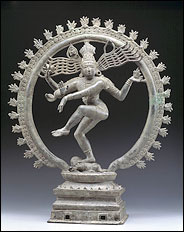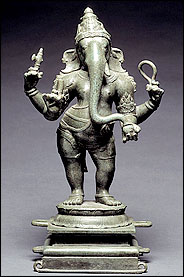| news | | archive | | email | | links | | current issue | |

|
New York Times : December 6, 2002 WASHINGTON, D.C. — An exhibition at the Arthur M. Sackler Gallery here, "The Sensuous and the Sacred: Chola Bronzes From South India," doesn't waste much time. Its opening salvo, unleashed within mere yards of the entrance, consists of three spectacular bronzes of the Hindu god Shiva as Nataraja, Lord of Dance. In each, Shiva balances on his right leg while crooking his left up and across his body, communicating the sense of imminent motion — be it a spin across the heavens or a tremor of devotion — that animates all great Indian sculpture.
("Shiva as Nataraja, Lord of Dance," left, and "Somaskanda," below, are among South Indian bronzes on view in "The Sensuous and the Sacred," at the Sackler Gallery in Washington.)
His famous dreadlocks are already fanning out from his head like an undulating musical score. His poised body is framed by a large hooplike aureole called a prabha, which is at once the circle of life and a ring of fire. After all, Shiva's dance is one of cosmic force that destroys and then recreates the world. Even the nonspecialist is likely to suspect that these astounding presences add up to the kind of artistic confab that curators and scholars of Indian art yearn for. Indeed. The dancing Shivas, lent by museums in Dallas and Amsterdam and an unnamed private collector, lead off a succession of works, many of which are well known and widely reproduced, that are rarely, if ever, seen in one another's company. A collaboration between the Sackler and the American Federation of Arts, this exhibition has been organized by Vidya Dehejia, a professor of art history at Columbia University and formerly the chief curator and deputy director of the Sackler. It is the first in the United States to concentrate solely on the bronze temple sculptures created during the nearly four-century reign of the devout, munificent and innovative Chola emperors. The Cholas ruled the South Indian region of Tamil Nadu, which centers on the holy river Kaveri and the city of Tanjore, from the middle of the 9th century to the late 13th century. At times, they expanded this empire to include Sri Lanka and the Maldives and sent emissaries as far as China. They built ever larger and more elaborate temples festooned with stone images of gods, goddesses and their acolytes; these were thriving centers of faith as well as of devotional dance, music and poetry. Each Chola temple contained a sanctum closed to all but select priests, within which dwelt the primary, emblematic but nonfigurative image of the god to whom the temple was dedicated — usually either Shiva or Vishnu, foremost among the numerous Hindu gods, all of whom are representatives of a higher unseen being. In an egalitarian impulse that seems intrinsic to Hindu heterogeneity, the idea that the gods should be accessible without priestly mediation had been gaining strength for some time. "The lord comes within everyone's reach" is how the great ninth-century Tamil poet-saint Nammalvar put it. The Chola rulers began commissioning bronze versions of the temples' stone depictions of the gods' different earthly incarnations — called avatars. A single temple required multiple images of its primary god, like Shiva as Lord of Dance, Destroyer of Three Cities and Seductive Mendicant. Unlike their stone counterparts, these bronze images were portable. Seen as living incarnations of the gods, they were ritually bathed and fed, and then clothed in lavish fabrics, jewels and flowers; they were carried through the streets like earthly rulers, as part of either elaborate festivals or daily rituals. This tradition fostered, and was fostered by, the refinement of a sophisticated lost-wax casting process, which had not yet been rediscovered in the West. Soon the components of a golden age were in place: until around 1250, when a period of political disintegration and violence began, the Chola oversaw a period that ranks among the world's high points of figurative sculpture, bronze-casting and religious tolerance. It would not be an overstatement to say that these sculptures are among the most beautiful ever made, in any material. There are 56 here and they easily overcome the first requirement of any Sackler show: distracting viewers from the depressing reality of a museum that is mostly underground, nearly devoid of natural light and plagued by a confusing missile-silo layout. The sculptures' transporting combination of formal perfection, religious gravity and life-affirming alertness can make the setting all but disappear. The show offers a reasonably full
contingent of gods, goddesses and saints that outlines the Hindu
firmament. Shiva and Vishnu appear in several different incarnations.
In other works, Shiva is accompanied by his consort, Uma (known
as Parvati in northern India). In the show's three "Somaskanda"
images, he appears with Uma and their son Skanda. Uma, for her part,
is present as the war goddess Durga or as the fierce Kali. The fabulously
full-bodied, elephant-headed Ganesh, another son of Shiva and Uma,
is also here, then as now one of the most popular forms for both
Hindu believers and sculptors. There is a spectacular figure of
Uma as the 10th-century Chola Queen Sembiyan Mahadevi, one of the
dynasty's first and greatest patrons. (The bronze dancing Shiva
form was an innovation of her workshops.) Also represented are several
of the Tamil poet-saints, the sometimes humble, sometimes noble
beings whose spontaneous poems became part of the temple liturgy
under the Chola.
(A South Indian bronze Ganesh (circa 1070), popular among Hindu sculptors.)
From the Nelson-Atkins Museum of Art in Kansas City, Mo., comes its famous Mother of Karaikkal, an ancient ascetic whose upright skeletal form nearly vibrates with religious fervor. From the Cleveland Museum of Art, there is a serene yet forceful image of Vishnu as his lion-man avatar, Yogi Narasimha, sitting in a yoga position, his legs folded in front of him (and encircled by a yoga band) two of his four elbows resting on his knees. Basking in the radiance of this extraordinary being, it is pertinent to recall that muddled descriptions of animal-headed, multiarmed figures like this caused Europeans to demonize Indian sculpture, contributing mightily to its art-historical neglect. While this exhibition will undoubtedly help specialists establish dates and provenance in royal and regional workshops, the opportunities to make stylistic and iconographical distinctions can be enjoyed by anyone. Consider, for example, the changing proportions, from elliptical to full-circle, of the Shiva Lord of Dance aureole, or the varying postures and expressions of the squirming dwarflike figure on which he stands. (That is Mushalagan, who represents darkness and ignorance.) Consider, too, the way the limbs of some figures curve and swell, while others are relatively straight; the way shoulders are sloped or exaggerated in width; the way some girdles seem almost part of the flesh — as in the Metropolitan Museum of Art's pair of small images of Shiva and Uma, for example — while elsewhere they encase the figure almost like armor. To Hindu worshippers, these extraordinary objects existed only at extremes, as either cosmic substance or dumb matter: they were either enlivened by the god's spirit or, once the rite or procession was over and the god had departed, they were an inanimate piece of household metal that needed to be vigorously and unceremoniously scrubbed before being resanctified. They were neither viewed nor fetishized as art. In fact, they were barely seen at all, given the amount of paraphernalia heaped upon them for their public outings. Even so, visual contact — called darshan, which literally translates as "seeing and being seen by God" — is the essential form of Hindu religious experience, the moment of blessing. In fact, eye contact is so essential that if an image's eyes were worn away by touching or cleansing, they were usually recarved into the face — as is the case with several works here. In addition, Hindu belief dictates that inner beauty and grace be reflected on the outside: beauty of form, proportion, gesture, expression and detail. Nothing — not an angle of a palm or the bend of a finger — is without meaning, devoid of symbolism or purely decorative. Shiva's earrings are always mismatched, to represent men and women. But with or without a deep understanding of Hinduism and its elaborate symbolism, these works communicate a beauty that is at once profoundly human and formally radical. It has everything do to with seeing. The Indian sculptors, in particular the Chola bronze sculptors, negotiated a truce between geometry and the organic, the abstract and the realistic, that is almost unknown to Western sculpture. The Egyptians achieved something similar, but they never set it in motion. This Indian sculpture, influenced by dance, was able to do. A kind of ecstatic clarity of living form resulted, expressed in the continuous play between taut curving lines and smooth curving planes. No matter what angle you view them from, the Chola bronzes at the Sackler almost invariably present the viewer with a simultaneous sense of crisp profile and a soft volume that adds up to an extraordinary sense of unity, of seeing everything at once in a microcosmic flash of revelation.
|
Akhand
Bharat Foundation © 2002 (All Rights Reserved)

